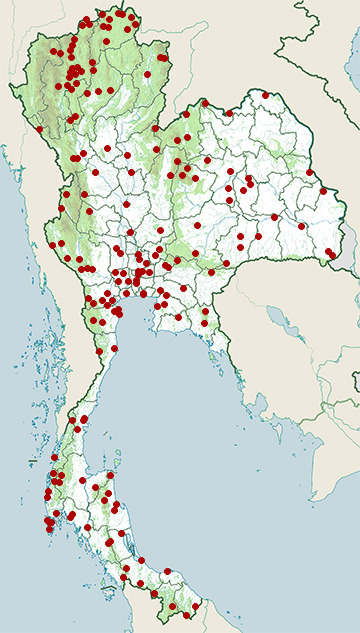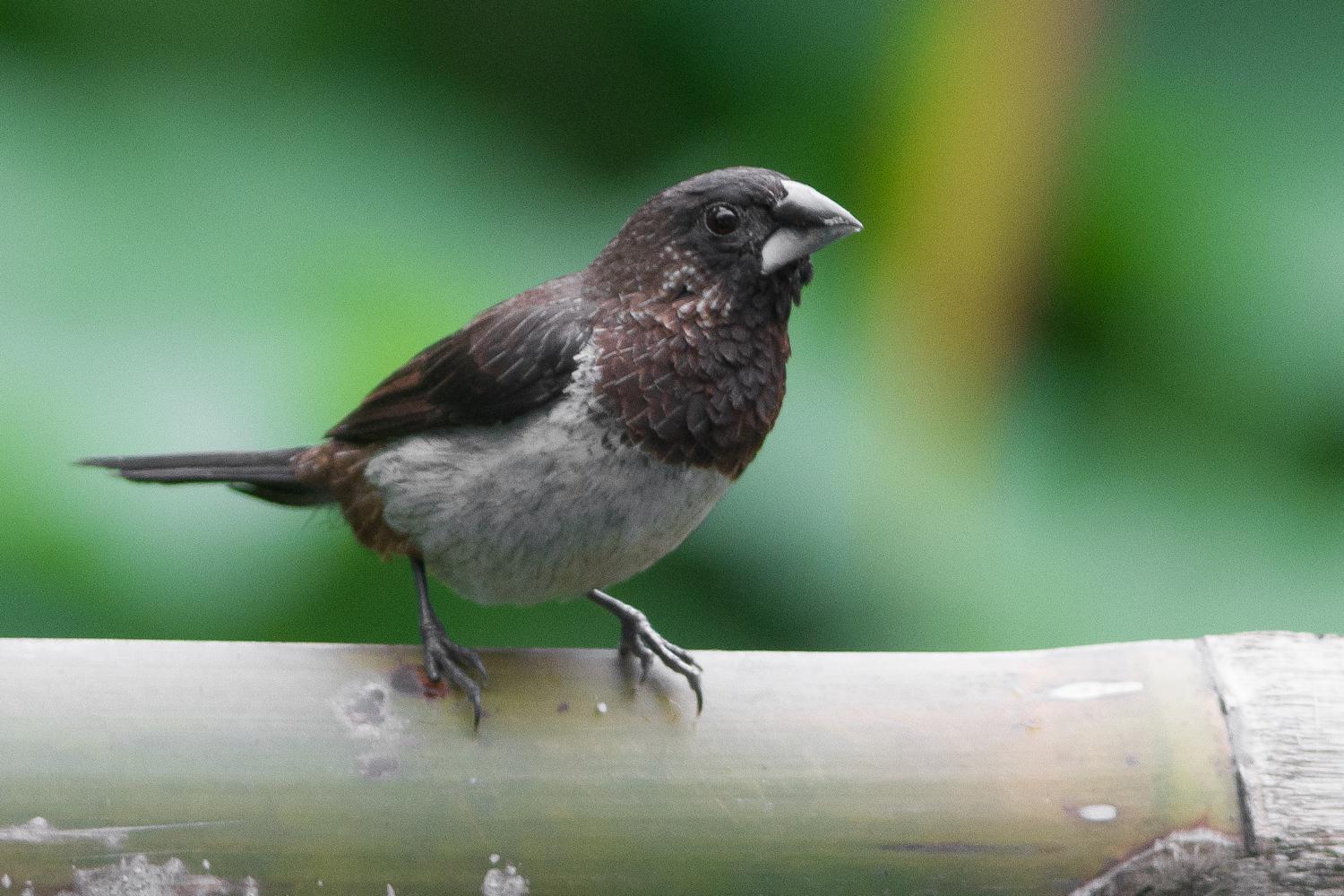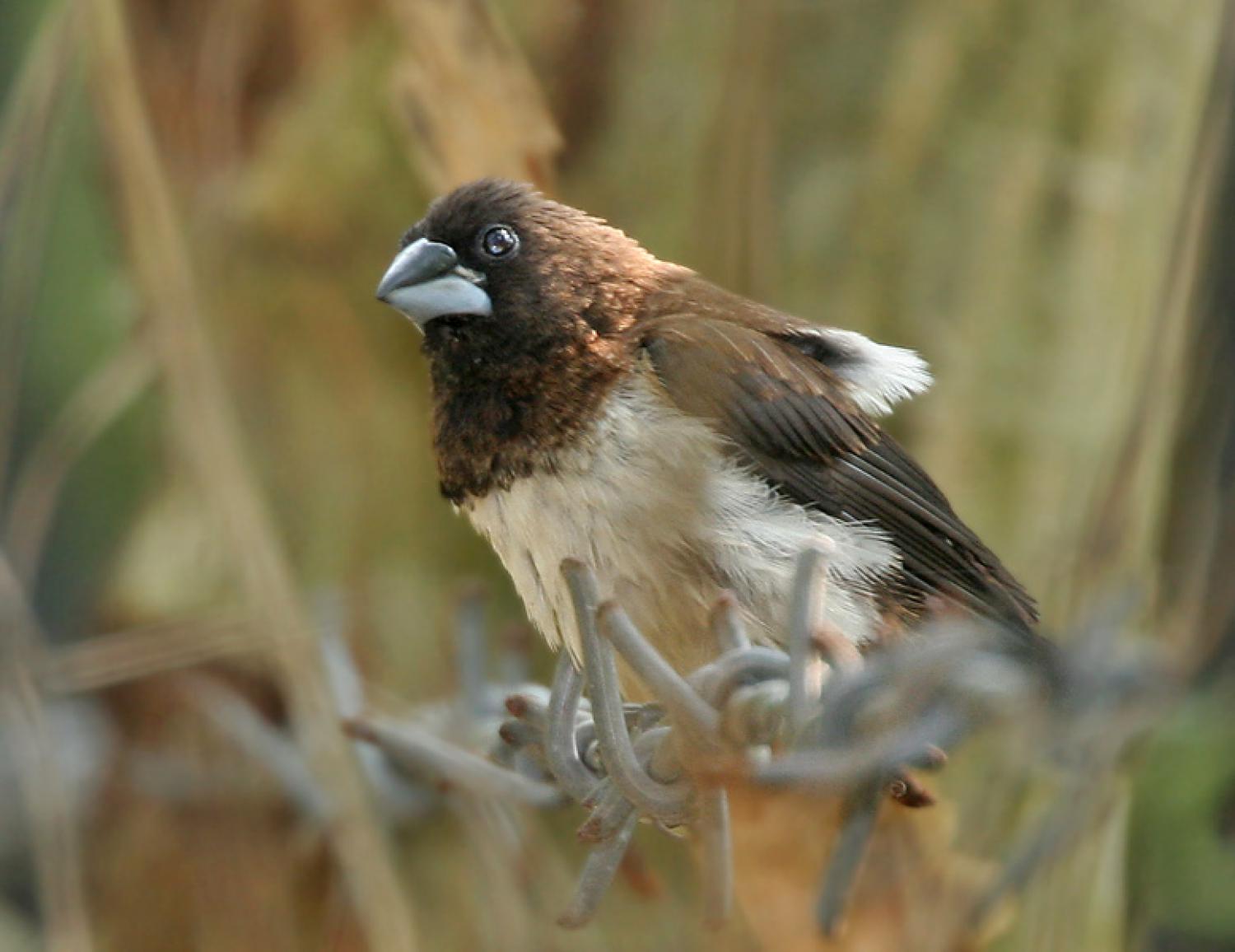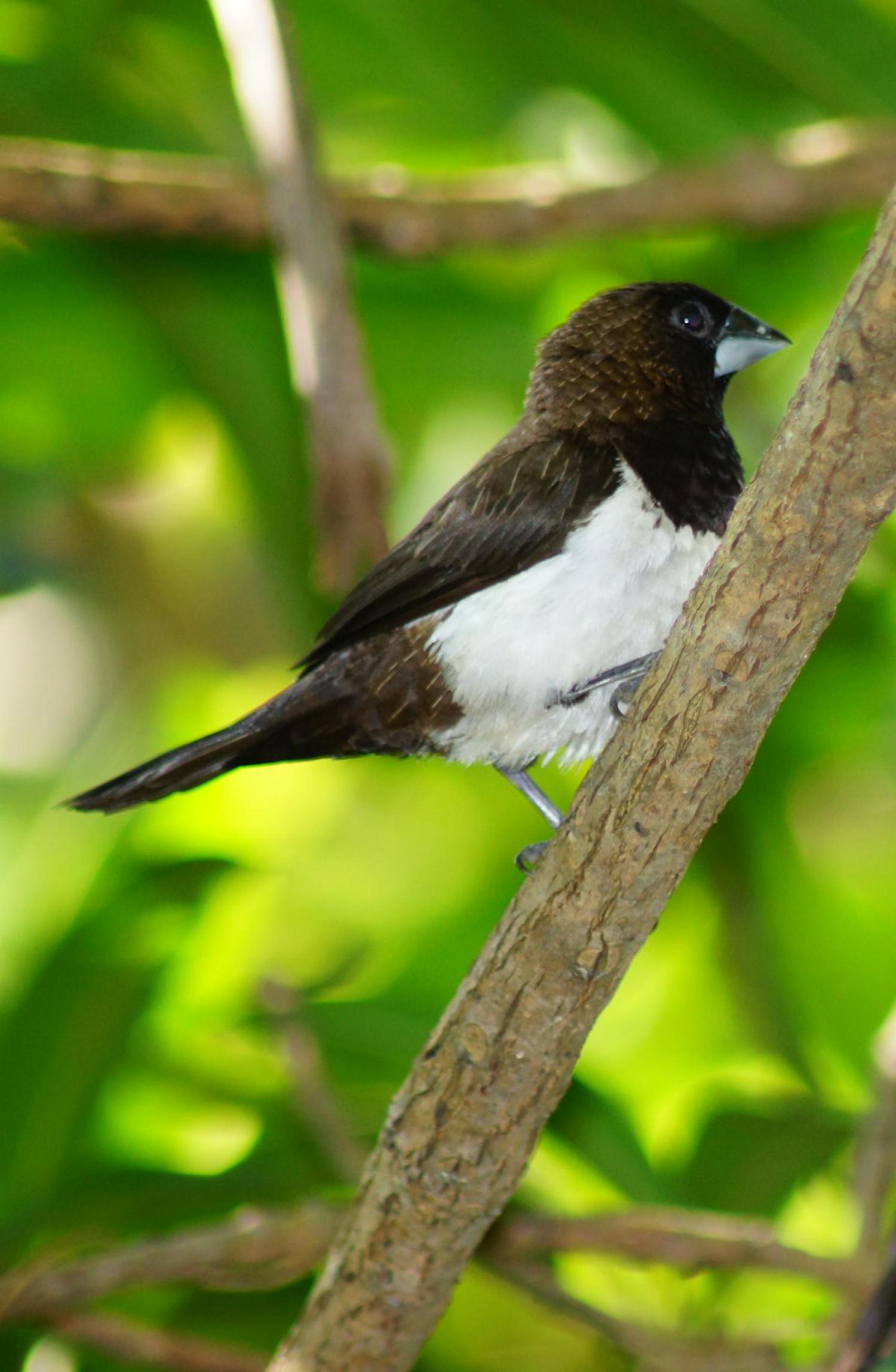Species of Thailand
White-rumped munia
Lonchura striata
Carolus Linnaeus, 1766
In Thai: นกกระติ๊ดตะโพกขาว
The white-rumped munia or white-rumped mannikin (Lonchura striata), sometimes called striated finch in aviculture, is a small passerine bird from the family of waxbill "finches" (Estrildidae). These are not close relatives of the true finches (Fringillidae) or true sparrows (Passeridae).
It is native to tropical continental Asia and some adjacent islands, and has been naturalized in some parts of Japan. Its domesticated hybrid descendant, the society finch or Bengalese finch, is found worldwide as a pet and a biological model organism.
Taxonomy
In 1760 the French zoologist Mathurin Jacques Brisson included a description of the white-rumped munia in his Ornithologie based on a specimen that he believed had been collected from the Isle de Bourbon (Réunion). The specimen is now assumed to have come from Sri Lanka. He used the French name Le gros-bec de l'Isle de Bourbon and the Latin Coccothraustes Borbonica. Although Brisson coined Latin names, these do not conform to the binomial system and are not recognised by the International Commission on Zoological Nomenclature. When in 1766 the Swedish naturalist Carl Linnaeus updated his Systema Naturae for the twelfth edition, he added 240 species that had been previously described by Brisson. One of these was the white-rumped munia. Linnaeus included a brief description, coined the binomial name Loxia striata and cited Brisson's work. The specific name striata is Latin for "striated ". This species is now placed in the genus Lonchura that was introduced by the English naturalist William Henry Sykes in 1832.
There are six subspecies:
- L. s. acuticauda (Hodgson, 1836) – northern Indian mainland below c. 1, 500 metres ASL, north through the Himalayas foothills of Bhutan and Nepal to the Dehradun region of Uttarakhand, India acroos to Bangladesh to northern Indochina
:Medium brown above, except on the face and remiges, buffy below
- L. s. striata (Linnaeus, 1766) – southern Indian mainland, Sri Lanka
:Dark chocolate-brown above, white below
- L. s. fumigata (Walden, 1873) – Andaman Islands
- L. s. semistriata (Hume, 1874) – Car Nicobar and Central (Nancowry) group, Nicobar Islands
- L. s. subsquamicollis (Baker, ECS, 1925) – Malay Peninsula to southern Indochina
- L. s. swinhoei (Cabanis, 1882) – east central and east China, Taiwan
A domesticated hybrid called the society finch, sometimes called Lonchura domestica is said by some sources to have striata in its ancestry although other theories suggest contributions from the white-throated munia. The hybrid with numerous variants in plumage are thought to have been established by aviculturists in Japan.
Description
The white-rumped munia is approximately 10 to 11 cm in length, with a stubby grey bill and a long black pointed tail. The adults are brown above and on the breast, and lighter below; the rump is white. There is some variation between the subspecies, but the sexes are almost impossible to distinguish in all subspecies; males have a more bulky head and bill.
Habitat and distribution
The white-rumped munia is a common resident breeder ranging from the Indian subcontinent to southern China east to Taiwan, and through Southeast Asia south to Sumatra; it frequents open woodland, grassland and scrub, and is well able to adapt to agricultural land use. It is a gregarious bird which feeds mainly on seeds, moving through the undergrowth in groups and sometimes accompanying other birds such as puff-throated babblers (Pellorneum ruficeps). The nest is a large domed grass structure in a tree, bush or grass into which three to eight white eggs are laid. They are also known to use abandoned nests of Baya weaver. They are often found near water and have been observed feeding on algae. It has been suggested that they obtain protein from their diet of algae often in the species Spirogyra, which grows in paddy fields.
It is a common and widespread bird across its large range, and is thus not considered a threatened species by the IUCN. In fact, it may locally become a nuisance pest of millets and similar grains. Even the Nicobar Islands subspecies with its limited range seems to be able to cope well with human settlement. As it is a drab-coloured and rather reclusive bird inhabiting dense undergrowth, the white-rumped munia is not necessarily conspicuous even where it occurs in considerable numbers.
Origin
Origin and phylogeny has been obtained. Estrildinae may have originated in India and dispersed thereafter (towards Africa and Pacific Ocean habitats).
This article uses material from Wikipedia released under the Creative Commons Attribution-Share-Alike Licence 3.0. Eventual photos shown in this page may or may not be from Wikipedia, please see the license details for photos in photo by-lines.
Category / Seasonal Status
BCST Category: Recorded in an apparently wild state within the last 50 years
BCST Seasonal status: Resident or presumed resident
Scientific classification
- Kingdom
- Animalia
- Phylum
- Chordata
- Class
- Aves
- Order
- Passeriformes
- Family
- Estrildidae
- Genus
- Lonchura
- Species
- Lonchura striata
Common names
- Thai: นกกระติ๊ดตะโพกขาว
Synonyms
- Uroloncha striata
Conservation status

Least Concern (IUCN3.1)
Photos
Please help us review the bird photos if wrong ones are used. We can be reached via our contact us page.
Range Map

- Amphawa District, Samut Songkhram
- Ao Phang-Nga National Park
- Ban Bueng District, Chonburi
- Ban Phai District, Khon Kaen
- Ban Pho District, Chachoengsao
- Bang Lang National Park
- Bang Len District, Nakhon Pathom
- Bang Pahan District, Phra Nakhon Si Ayutthaya
- Bang Phra Non-Hunting Area
- Bang Pu Recreation Centre
- Bangkok Province
- Borabue District, Maha Sarakham
- Bueng Boraped Non-Hunting Area
- Chae Son National Park
- Chiang Dao District, Chiang Mai
- Chiang Dao Wildlife Sanctuary
- Chiang Khan District, Loei
- Chiang Khong District, Chiang Rai
- Chiang Saen District, Chiang Rai
- Doi Inthanon National Park
- Doi Lang
- Doi Lo District, Chiang Mai
- Doi Pha Hom Pok National Park
- Doi Phu Kha National Park
- Doi Saket District, Chiang Mai
- Doi Suthep - Pui National Park
- Don Chedi District, Suphan Buri
- Erawan National Park
- Hala-Bala Wildlife Sanctuary
- Hang Chat District, Lampang
- Huai Chorakhe Mak Reservoir Non-Hunting Area
- Huai Kha Khaeng Wildlife Sanctuary
- Huai Nam Dang National Park
- In Buri District, Sing Buri
- Kaeng Khoi District, Saraburi
- Kaeng Krachan District, Phetchaburi
- Kaeng Krachan National Park
- Kaeng Som Maew Queen Sirikit Forest Park
- Kamphaeng Saen District, Nakhon Pathom
- Kanthararom District, Sisaket
- Kantharawichai District, Maha Sarakham
- Kaset Sombun District, Chaiyaphum
- Khanom District, Nakhon Si Thammarat
- Khao Banthat Wildlife Sanctuary
- Khao Chong
- Khao Khitchakut National Park
- Khao Lak - Lam Ru National Park
- Khao Luang National Park
- Khao Nam Khang National Park
- Khao Nan National Park
- Khao Phanom Bencha National Park
- Khao Phra - Bang Khram Wildlife Sanctuary
- Khao Phra Thaeo Wildlife Sanctuary
- Khao Sam Roi Yot National Park
- Khao Soi Dao Wildlife Sanctuary
- Khao Sok National Park
- Khao Yai National Park
- Khao Yoi District, Phetchaburi
- Khemarat District, Ubon Ratchathani
- Khlong Luang District, Pathum Thani
- Khlong Saeng Wildlife Sanctuary
- Khon San District, Chaiyaphum
- Khun Chae National Park
- Khun Nan National Park
- Khun Tan District, Chiang Rai
- Khura Buri District, Phang Nga
- Kui Buri National Park
- Kut Thing Non-Hunting Area
- Laem Pak Bia
- Laem Son National Park
- Lam Nam Kok National Park
- Lan Sang National Park
- Li District, Lamphun
- Mae Ai District, Chiang Mai
- Mae Chan District, Chiang Rai
- Mae Fa Luang District, Chiang Rai
- Mae Mo District, Lampang
- Mae Moei National Park
- Mae Ping National Park
- Mae Rim District, Chiang Mai
- Mae Taeng District, Chiang Mai
- Mae Wong National Park
- Mueang Chiang Mai District, Chiang Mai
- Mueang Chiang Rai District, Chiang Rai
- Mueang Chumphon District, Chumphon
- Mueang Kamphaeng Phet District, Kamphaeng Phet
- Mueang Kanchanaburi District, Kanchanaburi
- Mueang Khon Kaen District, Khon Kaen
- Mueang Krabi District, Krabi
- Mueang Lampang District, Lampang
- Mueang Lamphun District, Lamphun
- Mueang Maha Sarakham District, Maha Sarakham
- Mueang Nakhon Nayok District, Nakhon Nayok
- Mueang Nakhon Pathom District, Nakhon Pathom
- Mueang Nakhon Si Thammarat District, Nakhon Si Thammarat
- Mueang Nan District, Nan
- Mueang Nong Khai District, Nong Khai
- Mueang Nonthaburi District, Nonthaburi
- Mueang Pathum Thani District, Pathum Thani
- Mueang Pattani District, Pattani
- Mueang Phetchaburi District, Phetchaburi
- Mueang Phichit District, Phichit
- Mueang Phitsanulok District, Phitsanulok
- Mueang Phuket District, Phuket
- Mueang Ratchaburi District, Ratchaburi
- Mueang Samut Sakhon District, Samut Sakhon
- Mueang Songkhla District, Songkhla
- Mueang Sukhothai District, Sukhothai
- Mueang Suphanburi District, Suphan Buri
- Mueang Surin District, Surin
- Mueang Tak District, Tak
- Na Chaluai District, Ubon Ratchathani
- Nam Nao National Park
- Namtok Sam Lan National Park
- Non Din Daeng District, Buriram
- Non Thai District, Nakhon Ratchasima
- Nong Bong Khai Non-Hunting Area
- Nong Song Hong District, Khon Kaen
- Nong Yai Area Development Project Under Royal Init
- Op Khan National Park
- Pa Sak Chonlasit Dam Non-Hunting Area
- Pa Sang District, Lamphun
- Pachee River Wildlife Sanctuary
- Pai District, Mae Hong Son
- Pak Phli District, Nakhon Nayok
- Pak Thale
- Pak Tho District, Ratchaburi
- Pang Sida National Park
- Pha Daeng National Park
- Phan District, Chiang Rai
- Phanat Nikhom District, Chonburi
- Phra Nakhon Si Ayutthaya District, Phra Nakhon Si Ayutthaya
- Phra Phrom District, Nakhon Si Thammarat
- Phu Chong Na Yoi National Park
- Phu Hin Rong Kla National Park
- Phu Khiao Wildlife Sanctuary
- Phu Luang Wildlife Sanctuary
- Phu Pha Thoep National Park
- Phu Suan Sai National Park
- Phu Wiang National Park
- Phunphin District, Surat Thani
- Phutthamonthon District, Nakhon Pathom
- Rattanaburi District, Surin
- Sai Yok District, Kanchanaburi
- Sai Yok National Park
- Sakaerat Environmental Research Station
- Salak Pra Wildlife Sanctuary
- Samut Prakan Province
- San Kala Khiri National Park
- San Sai District, Chiang Mai
- Sanam Bin Reservoir Non-Hunting Area
- Sanam Chai Khet District, Chachoengsao
- Sangkhom District, Nong Khai
- Sawi District, Chumphon
- Sirinat National Park
- Sri Phang-nga National Park
- Su-ngai Kolok District, Narathiwat
- Tai Rom Yen National Park
- Taksin Maharat National Park
- Takua Pa District, Phang Nga
- Tat Mok National Park
- Thalang District, Phuket
- Thale Ban National Park
- Thale Noi Non-Hunting Area
- Thanyaburi District, Pathum Thani
- Thong Pha Phum District, Kanchanaburi
- Thong Pha Phum National Park
- Thung Yai Naresuan Wildlife Sanctuary
- Ton Nga-Chang Wildlife Sanctuary
- Umphang Wildlife Sanctuary
- Wang Chan District, Rayong
- Wang Mai Forest Restoration Project
- Wang Noi District, Phra Nakhon Si Ayutthaya
- Wang Saphung District, Loei
- Wat Phai Lom & Wat Ampu Wararam Non-Hunting Area
- Wiang Kaen District, Chiang Rai



